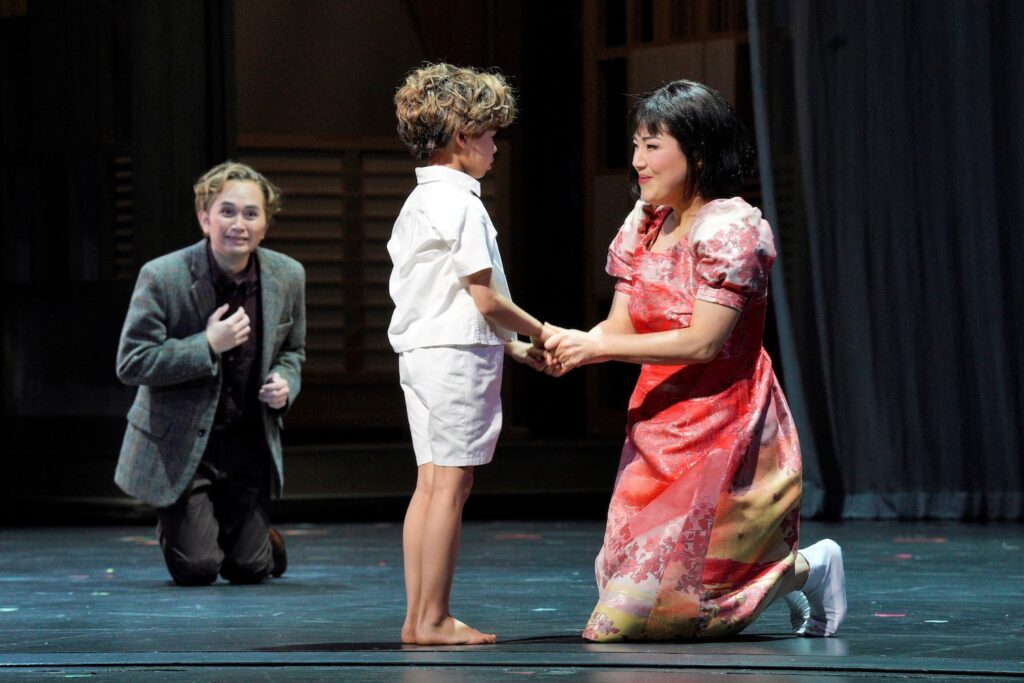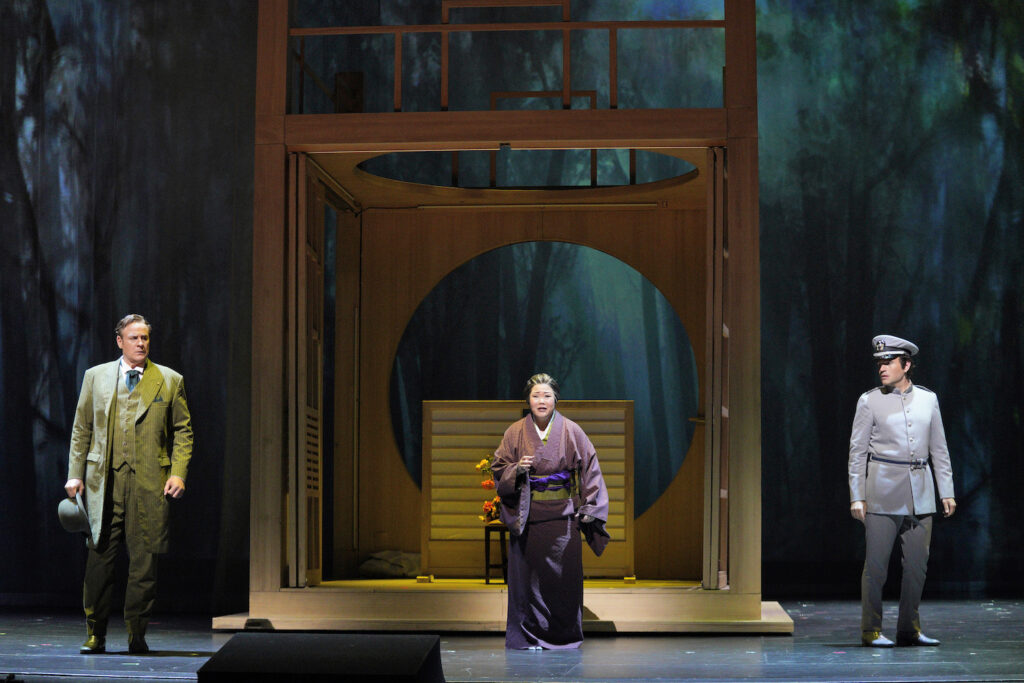Japanese stage director Amon Miyamoto’s Madama Butterfly was first seen in Tokyo, then traveled to Dresden before arriving just now in San Francisco. Unlike Puccini who made the tiny Japanese geisha his tragic heroine director Miyamoto made the American lieutenant Pinkerton the central figure in his take on San Franciscan David Belasco’s play of the same name (1900).
Further directorial revisions rendered this monument of Italian operatic verismo into the Grand Guignol theater (horror theater) of Puccini’s short story tryptic Il trittico [Il tabarro/Suor Angelica/Gianni Schicchi]. The dominant image of this Madama Butterfly was the deathbed of an aged B.F. Pinkerton that opened the show in absolute silence, and closed the show in Puccini’s violent thunder clap of emotional release.
Conductor Eun Sun Kim squelched its final cymbal crash with astonishing alacrity, capping once-and-for-all the hyper indulgent musicality of the evening.
The deathbed image of the Puccini’ comedic Gianni Schicchi hung heavily over this evening, furthering the sense that this full, three act opera was really only the short story it once was, with an interesting point it wished to make. To wit: a bi-racial child, here a thirty year-old man, must struggle mightily to reconcile his heritage.
Stage director Miyamoto’s Butterfly is said to tell the Butterfly story from the love child Trouble’s perspective, though for me the conceit worked more as a rhetorical device — the always present, silent thirty-some year old Trouble was my own sympathetic/empathic presence on the stage and in the action. This, far more than my participation in the discussion of a bi-racial adult to reconcile himself to his once callous, now repentant father — though one can admire the attempt to enliven such discourse within this current socio-political climate.

The production was a flashback, expressed in a letter written by the now quite old Pinkerton to his now adult son Trouble. Eastern European (many Warsaw credits) set designer Boris Kudlička created a very effective, indeed quite brilliant, evocation of recollection seen through the haze of time, precise images emerging from time to time, the atmospheres sympathetically lighted by Dresden’s Semperoper resident designer Fabio Antoci, with projections created by Warsaw Opera’s Bartek Macias.
The design conceit was the deployment of semi-transparent, cataract colored curtains that flew across the stage revealing moments of precise recollection, Butterfly a remembered presence, not a protagonist. At least this was the intention, though it was surely and intentionally ambiguous as Butterfly is a singularly powerful player both as a verismo heroine and a Grand Guignol puppet. The house was a small, abstract wooden structure that slid into sight upon occasion. One side of the house was a huge circle — the setting sun of Japanese iconography — that was bathed in brilliant red light to hide the Butterfly suicide.
It was a impressive evening, the first act achieving a surprising perfection, the Pinkerton and Sharpless well able to assimilate into the powerful musical flow imposed by conductor Eun Sun Kim. The second act introduced the young child Trouble who executed elaborate staging with confidence and finesse, the third act brought much staging for the young Kate Pinkerton (we had met the aged Kate in the opening tableau). These exaggerated presences disturbed the pacing of the emotional beats so knowingly created by Puccini, dragging the final scene of this verismo masterpiece into a lugubrious lethargy.
The audience however leapt to its feet, and remained standing through the bows (I.e. there was not the usual flight to be the first out of the theater).

Conductor Eun Sun Kim, as is her usual want, imposed a huge orchestral presence onto the production, the musical effects were often prolonged and sometimes exaggerated. Working with Messrs. Fabbiano and Meacham in the first act she found evident artistic sympathy and expressive amplitude making this act the highpoint of the evening.
Michael Fabiano brought consummate artistry to his role as B.F. Pinkerton. Of all his roles at San Francisco Opera, most notably Don Carlo and Cavaradossi, he seemed most at ease with Pinkerton. Add to this his considerable experience on the world’s major stages and you arrive at the solid characterization of this Pinkerton..
Much the same may be said for baritone Lucas Meachem, a frequent name over the years on the San Francisco Opera roster. His voice has retained a youthful luster and focus though it seemed smaller than when he once took on Rossini’s Figaro and Mozart’s Count. He assumed a magisterial presence for Sharpless that bespoke compassion without pathos, and understanding without judgement.
Korean soprano Karah Son enacted Butterfly. Of diminutive stature she made the fifteen year-old Cio-Cio-San seem really fifteen years old in her Act I processional entrance and following repartee with Pinkerton. Though sufficiently endowed vocally — crucial for Butterfly — and her upper voice totally secure (she took the d-flat with ease), at this point she does not have the freshness of voice to convince us that she is the real Cio-Cio-San. Here in San Francisco Mme. Son, in the context of the Miyamoto production, embodied the young geisha of the short story rather more than the tragic heroine of the Puccini opera.
In keeping with the ethnic purity conceit of the production Suzuki was beautifully rendered by Korean mezzo Hyona Kim, evidently a house singer In Dortmund, Germany. Goro was expertly rendered by Korean character tenor Julius Ahn, Prince Yamadori was grandly enacted and beautifully sung by Korean baritone Kidon Choi, though Korean bass-baritone, Adler Fellow Jongwon Han was over-parted as the Bonze.
The silent roles — the young Trouble, the 30-year-old Trouble, the aged B.F. Pinkerton — were impressively acted by local theater artists, Viva Young Maguire, John Charles Quimpo and Evan Miles O’Hare. There was no program photo or bio for Mlle. Maguire.
The balance of the named roles were taken by Adler Fellows (SF Opera’s young artist program) and members of the San Francisco Opera Chorus. The costumes worn by the chorus women in the Act I Butterfly entrance were delightfully sparkly, and the off stage women’s chorus of the Butterfly vigil was exceptionally beautiful.
The costumes were designed by the late Paris-based Japanese fashion icon Kenzo Takada, realized by Sonoko Takeda of the Tokyo Ballet.
Michael Milenski